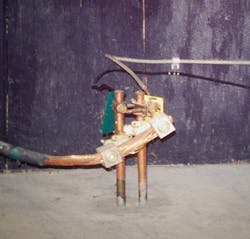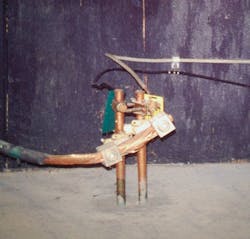How well do you know the Code? Think you can spot violations the original installer either ignored or couldn't identify? Here's your chance to moonlight as an electrical inspector and second-guess someone else's work from the safety of your living room or office. It's your turn to identify the violation.
Hint: Separation anxiety
Find the Answer
These two ground rods are simply too close together. Section 250.53(A)(3) of the 2011 NEC requires multiple rod type electrodes to be spaced no less than 6 ft apart. Proper spacing of the rods helps improve the paralleling efficiency of the rods, as explained in the Informational Note of this section.
Another problem is the ends of the rods are above ground. Section 250.53(G) explains the upper end of the rods must be flush with or below ground level unless protected from physical damage. If the rods are only 8 ft long, then there is less than 8 ft of length in contact with the soil. This would create another violation, since 250.53(G) also requires 8 ft of rod length to be in contact with the soil.
On a positive note, I would like to point out the fact that the communications systems and power systems are bonded together at the rod location. Section 800.100(B)(2)(1) permits the communication system grounding/bonding conductor to be connected to the building grounding electrode system as covered in 250.50. Bonding all the systems helps minimize voltage differences between the different wiring systems. Large voltage differences could occur and cause damage especially during a lightning storm if the systems were not bonded together.
About the Author

Russ LeBlanc
Owner
Russ started in the electrical trade as an apprentice in 1985. He worked his way up to become a Journeyman Electrician and then eventually became a Master Electrician and Licensed Construction Supervisor. In 1999 Russ become an Electrical Instructor for The Peterson School of Engineering in Massachusetts where he developed his passion for teaching, and quickly became Department Head of Electrical Instruction. Russ has taught thousands of apprentices, electricians, engineers, inspectors, and other electrical professionals during his career as an instructor. He continues to provide electrical professionals with Electrical Code seminars, Arc-Flash Awareness training seminars and educational material through his LeBlanc Consulting Services in North Reading, MA whose specialty is educating electricians. He has been an active member of the NFPA Electrical Section and has authored hundreds of National Electrical Code proposals and comments which have become Code rules to improve the safety for the electrical industry. Russ is also an IAEI certified Electrical Inspector.
Please visit www.russleblanc.net for more information.

